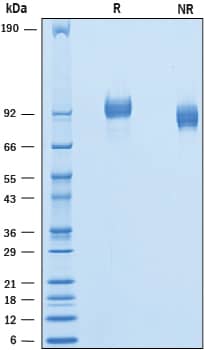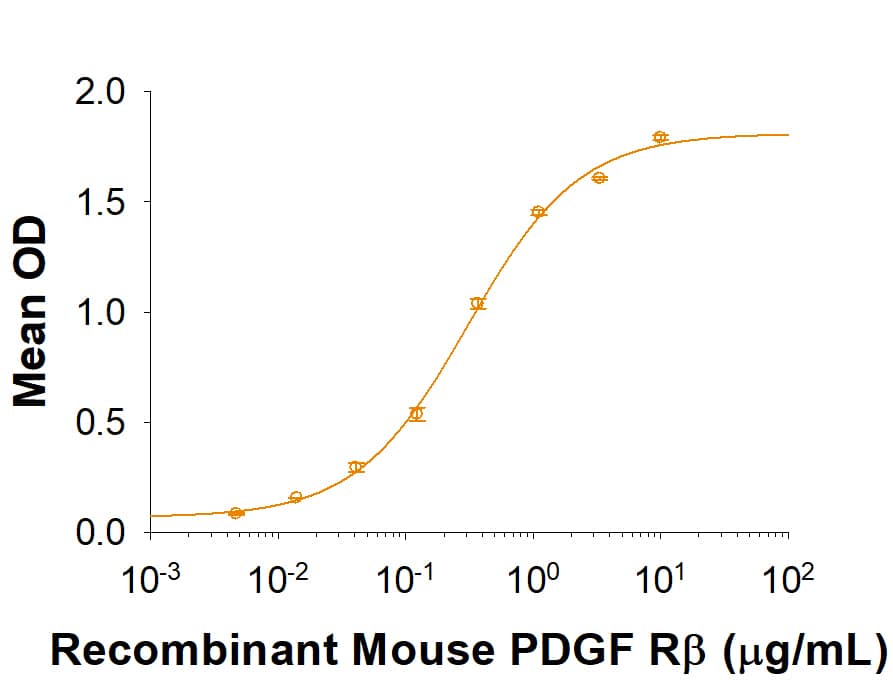Recombinant Mouse PDGF R beta His-tag Protein, CF
R&D Systems, part of Bio-Techne | Catalog # 10066-PR

Key Product Details
Product Specifications
Source
Leu32-Lys530, with a C-terminal 6-His tag
Purity
Endotoxin Level
N-terminal Sequence Analysis
Predicted Molecular Mass
SDS-PAGE
Activity
When Recombinant Rat PDFG-BB (Catalog # 520-BB/CF) is immobilized at 2 µg/mL (100 µL/well), the concentration of Recombinant Mouse PDGF R beta that produces 50% of the optimal binding response is 0.25-1.5 μg/mL.
Scientific Data Images for Recombinant Mouse PDGF R beta His-tag Protein, CF
Recombinant Mouse PDGF R beta His-tag Protein Binding Activity
When Recombinant Rat PDGF-BB Homodimer (Catalog # 520-BB/CF) is coated at 2 µg/mL (100 µL/well), Recombinant Mouse PDGF R beta (Catalog # 10066-PR) binds with an ED50 of 0.25-1.5 µg/mL.Recombinant Mouse PDGF R beta His-tag Protein SDS-PAGE
2 μg/lane of Recombinant Mouse PDGF R beta was resolved with SDS-PAGE under reducing (R) and non-reducing (NR) conditions and visualized by Coomassie® Blue staining, showing bands at 89-103 kDa.Formulation, Preparation and Storage
10066-PR
| Formulation | Lyophilized from a 0.2 μm filtered solution in PBS. |
| Reconstitution | Reconstitute at 500 μg/mL in PBS. |
| Shipping | The product is shipped at ambient temperature. Upon receipt, store it immediately at the temperature recommended below. |
| Stability & Storage | Use a manual defrost freezer and avoid repeated freeze-thaw cycles.
|
Background: PDGF R beta
The platelet-derived growth factor (PDGF) family consists of proteins derived from four genes (PDGF-A, -B, -C, and -D) that form disulfide-linked homodimers (PDGF-AA, -BB, -CC, and -DD) and a heterodimer (PDGF-AB) (1, 2). These proteins regulate diverse cellular functions by binding to and inducing the homo- or hetero-dimerization of two receptors (PDGF R alpha and R beta). Whereas alpha/ alpha homo-dimerization is induced by PDGF-AA, -BB, -CC, and -AB, alpha/ beta hetero-dimerization is induced by PDGF-AB, -BB, -CC, and -DD, and beta/ beta homo-dimerization is induced only by PDGF-BB, and -DD (1 - 4). Both PDGF R alpha and R beta are members of the class III subfamily of receptor tyrosine kinases (RTK) that also includes the receptors for M-CSF, SCF and Flt3-ligand. All class III RTKs are characterized by the presence of five immunoglobulin-like domains in their extracellular region and a split kinase domain in their intracellular region. Ligand-induced receptor dimerization results in autophosphorylation in trans resulting in the activation of several intracellular signaling pathways that can lead to cell proliferation, cell survival, cytoskeletal rearrangement, and cell migration. Many cell types, including fibroblasts and smooth muscle cells, express both the alpha and beta receptors. Others have only the alpha receptors (oligodendrocyte progenitor cells, mesothelial cells, liver sinusoidal endothelial cells, astrocytes, platelets and megakaryocytes) or only the beta receptors (myoblasts, capillary endothelial cells, pericytes, T cells, myeloid hematopoietic cells and macrophages). A soluble PDGF R alpha has been detected in normal human plasma and serum as well as in the conditioned medium of the human osteosarcoma cell line MG-63 (5). Both the recombinant mouse and human soluble PDGF R alpha bind PDGF with high affinity and are potent PDGF antagonists.
References
- Betshotz, C. et al. (2001) BioEssays 23:494.
- Ostman, A. and A.H. Heldin (2001) Advances in Cancer Research 80:1.
- Gilbertson, D. et al. (2001) J. Biol. Chem. 276:27406.
- LaRochells, W.J. et al. (2001) Nature Cell Biol. 3:517.
- Tiesman, J. and C.E. Hart (1993) J. Biol. Chem. 5:9621.
Long Name
Alternate Names
Gene Symbol
UniProt
Additional PDGF R beta Products
Product Documents for Recombinant Mouse PDGF R beta His-tag Protein, CF
Product Specific Notices for Recombinant Mouse PDGF R beta His-tag Protein, CF
For research use only

